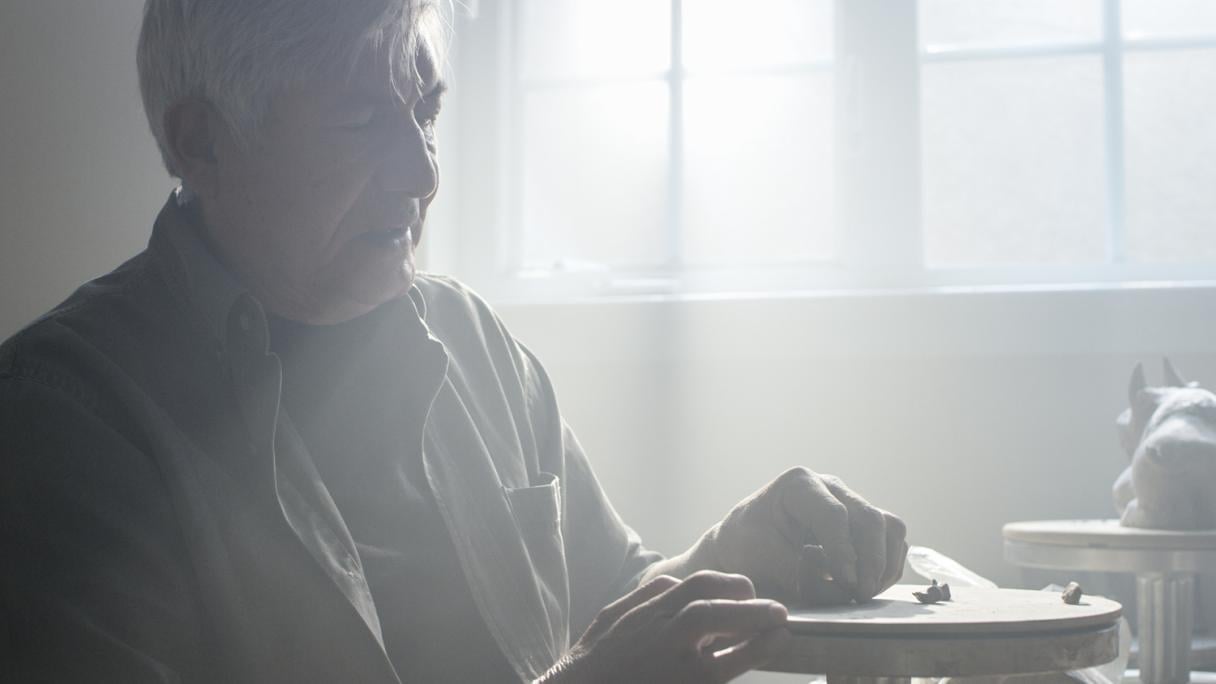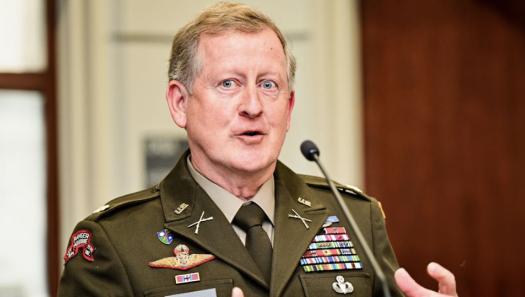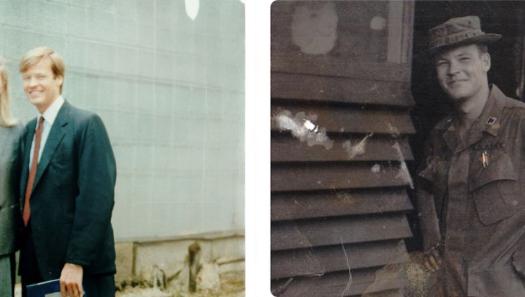WeSalute Awards
HeroVet: Michael Naranjo, Vietnam Veteran and Sculptor

He remembers, in exquisite detail, the last person he ever saw: the Viet Cong soldier who threw the grenade that took his sight, maimed his hand and threatened his dream of becoming an artist.
Michael Naranjo, a Tewa Indian of the Santa Clara Pueblo in north-central New Mexico, was still green, a novice to the ways of combat, in-country less than two months, when his life was shattered on a day he can never forget: January 8, 1968.
Assigned to the 9th Infantry, his platoon was on patrol, searching for the VC who had mortared their base camp the night before, when they were caught in an ambush.
His squad was maybe fifty yards from the jungle when they started taking automatic weapons fire from the tree line.
"We hit the dirt," Michael remembers, and despite the chaos, he felt "a sudden dead calmness." His instincts took over—sometimes "you can never know why people do what they do" in combat, he says—and, jumping up from the relative safety of his position, hunched over, moving in spurts, he rushed the tree line where enemy soldiers were entrenched.
Fifteen yards from the edge of the jungle, nuzzled by the protective wall of a dike, he could hear the VC move around even as he saw some of his buddies get hit. His sergeant and a medic slid in beside him and, before Michael could dissuade him, "Doc just got up over the dike and rolled off," trying to make his way to two wounded comrades.
Michael and his squad sergeant followed, dashing into the jungle. Michael found cover in a little mud depression. He could see the spider holes that provided camouflage for Charlie. And he could see one Viet Cong "who quick-turned his head toward me." "For a split second," Michael remembers, "I was looking into his eyes." What Michael didn’t see was the grenade, which rolled next to him and exploded, maiming his right hand and destroying his eyes.
"I knew then I was going to die," Michael says. "My last thought before I lost consciousness was, ‘Dear God, don’t make it too hard on my parents.’"
Key to Recovery
Michael Naranjo didn’t die. He was pulled out of more immediate danger by his sergeant, whose name he wishes he could remember. Four fellow grunts then hoisted him onto a poncho and, dodging the intense ground fire, flung him into a waiting MedEVac chopper. Slipping in and out of consciousness, he woke up a day and a half later at the 24th Evacuation Hospital in Saigon, confronted by the new reality of his life: one eye was gone—the other would have to be removed a few years later—and his right hand was badly damaged, leaving him with minimal feeling and dexterity. His childhood dream of becoming a sculptor seemed as shattered as his body.
Days later, recuperating in a hospital in Japan, Michael asked to be moved from a private room where the doctors thought the quiet would assist recovery, but where he felt he was going crazy. It was in the ward where he was sent, among rows and rows of the mangled and the maimed, many faced with life-threatening injuries and uncertain futures, that Michael Naranjo began his rehabilitation. Queried by a volunteer if there was anything she might bring him, he asked for some water-based clay. A few days later, she fulfilled his request.
And Michael began the slow and painful process of regaining his life. Tearing off a piece of clay with his left hand, he rolled it up into a golfball-sized sphere, then elongated it. He gave it a head and a face. At that point, says Michael, "I knew I could do it. It was exhilarating! Soon I progressed to goldfish and squirrels. And this made all the difference in the world."
Fulfilling a Dream
For Michael Naranjo, becoming a sculptor had been his dream since boyhood. His mother, Rose, and many of his relatives made the acclaimed Santa Clara black pottery from the abundant clay on the reservation near Santa Fe. Young Michael molded this clay, creating little creatures he’d seen in the forest. In college, he took art classes, which he figured would help him fulfill his ambition. Then he got drafted.
After he was wounded, his grievous injuries did not dissuade him from pursuing his goals. On the first day of December, 1968, sitting at the kitchen table of his parents’ home in Taos, Michael informed them he wanted to move to Santa Fe, to begin his career.
"How will you eat?" his father wanted to know. "I’ll learn to cook," Michael replied. He did move to Santa Fe, and wound up eating a lot of canned soup and TV dinners before he learned to navigate around the kitchen. He found an artist who taught him how to sculpt using the lost-wax process.
"Then," he knew, "it was all up to me."
In the years since, Michael Naranjo married—Laurie became his bride in 1978—and fathered two daughters now in college and became a sculptor of note: The Artist Who Sees with His Hands. During a visit to Italy, scaffolds were constructed so that he might touch and find inspiration in Michelangelo’s David. Which inspired Michael to work in stone as well as in bronze.
Today, his creations—of nudes and Native Americans, mythical creatures, centaurs and cherubs—are in museums and prominent collections around the world, including the White House and the Vatican. While most of his works are life-size, several are monumental: he is currently working on a 12-foot tall Native American hoop dancer.
Michael is philosophical about the wounds that interrupted his life. "Being blind makes the pace of life slower; you can’t walk fast or grab for things quickly," he says. "Life is more gentle and soft and the change brought my creative energies out."
None of his human figures are created with eyes, however, which he attributes to an unconscious decision on his part. "Maybe it’s because I don’t see the world using eyes," Michael muses. And he has never done a soldier, although he says he may, someday.
Because he "sees" with his hands, Michael encourages visitors to touch his work, to experience the artwork in the same manner that he does—through sight and feel. He believes that texture is an important element in artwork, and that it can make a difference in how a piece is interpreted. He wants visitors—to the museums where he exhibits, and to galleries which show his work—to fully experience the "liquid feeling" with which he imbues he creations.
For Michael Naranjo, it’s not enough simply to have had success in his chosen field, or to accept the accolades offered—among them the "Outstanding Disabled Veteran of the Year" award in 1999 from the Disabled American Veterans and during that same year he received the LIFE Presidential Unsung Hero Award - It is more important to give something back. He lives his belief that "disabilities should not prevent anyone from reaching their potential," and makes time to teach art to people, young and old. In one recent workshop, he and four students created a bronze elk; none of the four had ever worked in this medium before.
In spite of, and perhaps because of, his encounter with a grenade on that January morning 33 years ago, Michael Naranjo’s life and accomplishments have come to reflect an adage from which all of us can all profit: success and defeat both are teachers.
Michael lives with his wife and two daughters in the adobe home he has designed. It is here he has his studio and gallery. He and his wife have established the Touched by Art Fund at the Santa Fe Community Foundation to enable public school students in New Mexico to visit galleries d museums. Michael's pieces are included in the collections of The Vatican, Vatican City, Italy; The White House, Washington D.C. and The Heard Museum, Phoenix, Arizona.
Image Credit: http://www.dreamtouchbelieve.com/projects/


